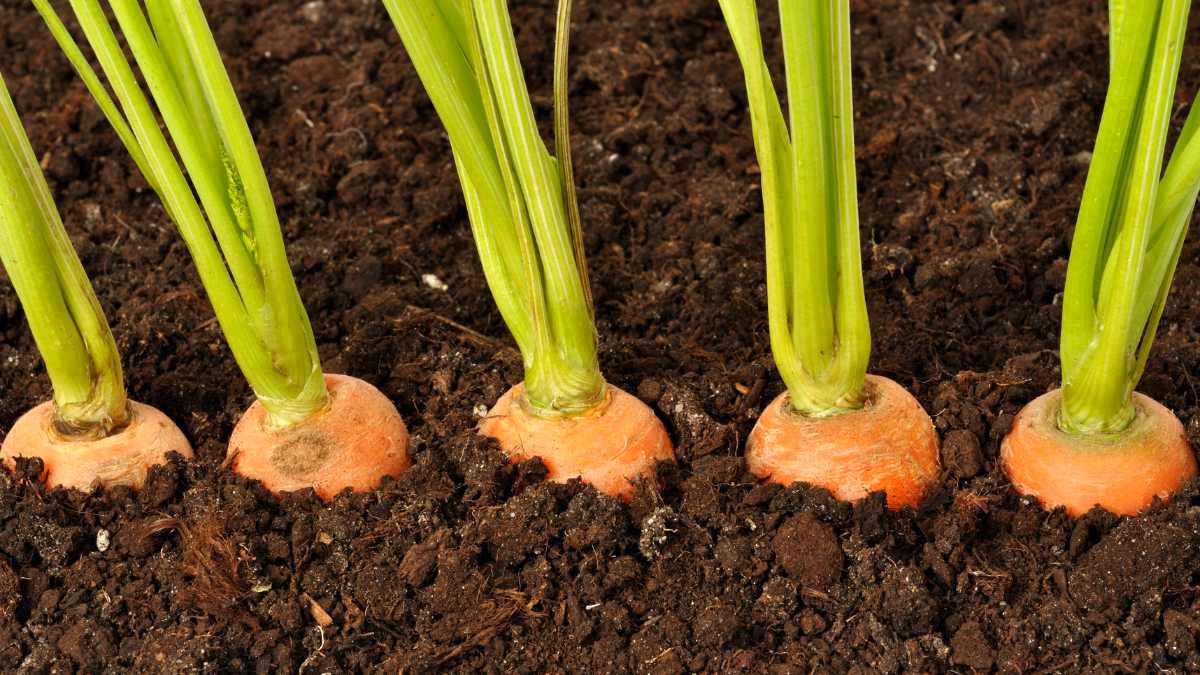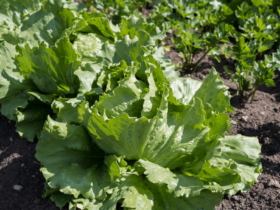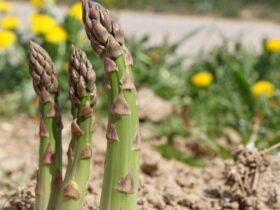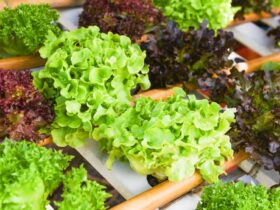Growing stages of Carrots from seed germination to root maturity, namely: seed germination, seedling growth, vegetative growth, root development, and root maturity. Carrots are a root vegetable that goes through distinct stages of growth, starting with the germination of seeds and ending with mature roots.
As the seeds germinate, tiny seedlings emerge and grow into young plants, experiencing vegetative growth with the development of leaves and stems. Over time, the roots start to develop, leading to the formation of mature, edible carrots. Understanding these growing stages is essential for successful carrot cultivation and optimal harvest.
We will explore each stage in detail, providing insights into the requirements and care needed for healthy carrot growth.
Selecting Carrot Seeds
One of the first steps in growing carrots is selecting the right seeds. The type of carrot seeds you choose can make a significant difference in the success of your growing efforts. There are a few key factors to consider when selecting carrot seeds, such as variety selection and quality assessment.
Variety Selection
When it comes to selecting a carrot variety, you’re spoilt for choices. Carrots come in various shapes, sizes, and colors. Some are long and slender, while others are short and stout. Additionally, you can find carrots in vibrant orange, deep purple, and even white varieties. The choice ultimately depends on your personal preference and specific growing conditions. Consider factors such as soil type, climate, and available space when selecting a carrot variety.
Quality Assessment
Ensuring the quality of the carrot seeds is crucial for a successful harvest. Quality assessment involves examining the health of the seeds and their viability for germination. Look for seeds that are plump, firm, and intact. Avoid seeds that are discolored, shriveled, or damaged. Additionally, it’s helpful to check the seed packet for the germination rate. Aim for seeds with a high germination rate to increase the chances of successful growth.
In conclusion, selecting carrot seeds is an important step in the growing process. By considering variety selection and quality assessment, you can set yourself up for a bountiful carrot harvest.

Preparing The Soil
One of the most important stages in growing healthy carrots is preparing the soil. The quality and condition of the soil can significantly impact the growth and development of carrots. In this section, we will discuss the different aspects of preparing the soil for planting carrots, including the appropriate soil type, soil preparation techniques, and the importance of pH and nutrient levels.
Soil Type
Before you start planting carrots, it is essential to consider the type of soil you have in your garden. Carrots thrive best in well-drained sandy or loamy soil with a light texture. Such soil types allow the carrot roots to penetrate easily and promote proper development. Avoid heavy clay soils as they can hinder root growth and result in misshapen carrots.
Soil Preparation
Proper soil preparation is crucial for successful carrot cultivation. Begin by removing any debris, rocks, or weeds from the planting area. Carrots require loose soil, so break up any compacted areas using a garden fork or tiller. Ensure that the soil is fine and crumbly, which would facilitate root penetration and proper growth.
Moreover, it is beneficial to incorporate organic matter, such as well-rotted compost or aged manure, into the soil. This not only improves soil structure but also enhances nutrient availability for the carrots. Spread a layer of organic matter onto the soil surface and mix it in thoroughly using a garden fork or tiller.
Ph And Nutrient Levels
The pH level and nutrient content of the soil greatly influence carrot growth. Carrots prefer slightly acidic to neutral soil, with a pH range of 6.0 to 7.0. Test your soil’s pH using a soil testing kit and adjust it accordingly by adding lime or sulfur.
In terms of nutrient levels, carrots primarily require adequate levels of phosphorus and potassium. Incorporate a balanced fertilizer into the soil before planting to ensure proper nutrient availability for the carrot plants. Follow the manufacturer’s instructions for the appropriate amount and distribution of the fertilizer based on the soil’s nutrient requirements.
To summarize, when preparing the soil for growing carrots, choose a well-drained sandy or loamy soil type, ensure the soil is loose and free from debris, and incorporate organic matter to improve soil structure. Adjust the pH level using lime or sulfur and provide adequate nutrients through the use of balanced fertilizers. By taking these necessary steps, you can create ideal growing conditions for your carrots, leading to healthy, flavorful harvests.
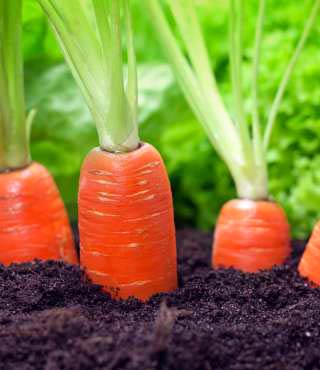
Planting Carrots
Planting carrots is an exciting process that requires careful consideration of timing, sowing techniques, and seed spacing and depth. By following the right practices, you can ensure a successful start to growing your own delicious and nutritious carrots. Let’s explore each stage in detail.
Timing
Choosing the right time to plant your carrots is crucial for their overall growth and development. Carrots thrive in cool weather conditions, preferring temperatures between 60°F and 70°F (15°C to 21°C). It is best to sow carrot seeds in early spring or fall to avoid extreme heat, which can inhibit germination and lead to poor quality roots.
Hot Tip: A great way to determine the optimal planting period is to focus on your region’s first and last frost dates. Aim to plant your carrot seeds about three weeks before the last expected frost date in spring and three weeks before the first expected frost date in fall.
Sowing Techniques
Successful sowing techniques play a vital role in obtaining healthy carrot plants. It is essential to create a well-prepared soil bed that is free from stones, rocks, or compacted soil. Carrots require loose, well-draining soil to allow their taproots to develop freely.
To ensure optimal germination, the soil should have a pH level ranging between 6.0 and 6.8. Adding organic matter, such as compost or well-rotted manure, can help improve the soil’s structure and fertility, providing the perfect environment for your carrot seeds to thrive.
Once the soil is ready, sow the carrot seeds directly into the ground. Ensure they are spaced adequately to prevent overcrowding and competition for resources. In general, aim to sow the seeds about 1 inch (2.5 cm) apart in rows that are approximately 12 to 18 inches (30 to 46 cm) apart.
Seed Spacing And Depth
The spacing and depth at which you sow your carrot seeds contribute to their future growth. It is important to sow the seeds at the appropriate depth, as planting too shallow or too deep can impact germination.
Pro Tip: For optimal results, sow carrot seeds at a depth of about ¼ to ½ inch (0.6 to 1.3 cm). A general rule of thumb is to plant the seed at a depth roughly twice its diameter.
When it comes to seed spacing, ensure each carrot seed has enough space to grow and develop fully. Thinly spread the seeds along the row, allowing about 2 inches (5 cm) between each seed. This spacing gives the roots enough room to expand and prevents them from competing for nutrients and moisture.
Remember: Thinning is necessary once the carrot seedlings are around 2 inches (5 cm) tall, as this ensures the remaining plants have adequate space to mature.
| Timing | Sowing Techniques | Seed Spacing and Depth |
| Choose early spring or fall for planting | Prepare well-draining soil with a pH of 6.0-6.8 | Sow seeds at a depth of ¼ to ½ inch (0.6 to 1.3 cm) |
| Consider first and last frost dates | Add organic matter for improved soil structure | Space seeds about 2 inches (5 cm) apart |
By understanding the importance of timing, sowing techniques, and seed spacing and depth, you can confidently plant your carrot seeds and set the stage for a successful and bountiful harvest. Now that you know how to plant carrots, it’s time to move on to the next stages of their growing journey!
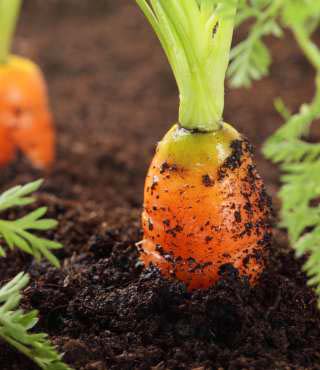
Watering And Mulching
Watering and mulching are essential for the healthy growth and development of carrots. Proper watering techniques ensure that the plants receive adequate moisture, while mulching helps to conserve water, suppress weeds, and maintain a stable soil temperature. Understanding the watering requirements and benefits of mulching will help you grow healthy and vibrant carrots.
Watering Requirements
Carrots require consistent and thorough watering throughout their growing stages to ensure proper root development and prevent cracking. Here are some key watering tips to keep in mind:
- Regular watering: Carrots need about 1-2 inches of water per week. It’s important to water regularly, especially during dry spells, to ensure adequate moisture for their growth.
- Deep watering: Water carrots deeply, ensuring the moisture reaches the full length of their long roots. This encourages the roots to grow deep into the soil, resulting in healthier and stronger plants.
- Avoid overwatering: While it is crucial to provide enough moisture, overwatering can lead to rotting and disease. Ensure that the soil is well-draining, allowing excess water to escape.
- Consistent moisture: Carrots prefer consistent moisture levels, so make sure the soil remains evenly moist, avoiding both overly dry and waterlogged conditions.
Mulching Benefits
Mulching offers numerous benefits to carrot plants, improving their overall growth and productivity. Here are some advantages of mulching:
- Water conservation: Mulching helps to conserve water by reducing evaporation. It acts as a protective barrier, ensuring that the soil retains moisture and the carrots receive a continuous water supply.
- Weed suppression: Mulch inhibits the growth of weeds by blocking sunlight and preventing weed seeds from germinating. This reduces competition for resources, allowing carrots to thrive without the interference of unwanted plants.
- Temperature regulation: Mulch acts as an insulating layer, regulating the soil temperature. It keeps the soil cooler in hot weather and warmer during colder periods, providing a more stable environment for carrot growth.
- Soil protection: Mulch protects the soil from erosion caused by heavy rain or strong winds. It also helps to prevent crusting, which can hinder the emergence of carrot seedlings.
- Organic matter addition: As the mulch breaks down, it enriches the soil with organic matter, enhancing its fertility and improving its structure. This benefits the overall health and nutrient availability for the carrot plants.
By following proper watering techniques and incorporating mulching into your carrot growing routine, you can create the ideal environment for healthy and flourishing carrot plants.
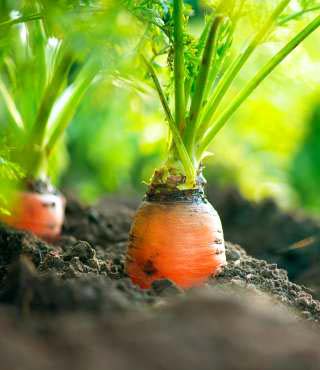
Caring For Carrots
Caring for carrots is essential during their growing stages. From planting to harvesting, these root vegetables require proper watering, sunlight, and regular weeding for optimal growth.
Thinning Seedlings
Thinning is an essential step in caring for carrot seedlings. Once the seedlings have reached a height of about 1-2 inches, you’ll need to thin them out. This simply means removing some of the seedlings to give the remaining ones enough space to grow.
To thin the seedlings, gently pull out the weaker ones, leaving only the healthiest and strongest plants. Aim to have the seedlings spaced about 2-3 inches apart.
Benefits of Thinning:
- Allows the remaining plants to receive enough sunlight, water, and nutrients.
- Prevents overcrowding, which can lead to stunted growth and smaller carrots.
- Improves air circulation, reducing the risk of disease and fungal infections.
Weed Control
Weeds can compete with carrots for nutrients, water, and sunlight, so it’s important to keep them under control. Here are some effective weed control methods for caring for carrots:
- Handweeding: Regularly inspect your carrot patch and remove any weeds by hand, ensuring you pull them out from the roots to prevent regrowth.
- Mulching: Apply a layer of organic mulch around the base of the carrot plants to suppress weed growth. This will also help retain moisture in the soil.
- Pre-emergent herbicides: If necessary, you can use pre-emergent herbicides to prevent weed seeds from germinating. However, be cautious and read the instructions carefully, as some herbicides can harm carrot plants.
Note: It’s important to keep in mind that handweeding and mulching are preferable methods as they are more eco-friendly and pose no harm to your carrots.
Pest And Disease Management
Carrots are vulnerable to a variety of pests and diseases, but with proper management, you can protect your crop effectively. Here are some key tips for pest and disease management:
- Aphid control: Check for aphid infestations regularly and use organic insecticidal soap or neem oil to control them.
- Carrot fly prevention: Carrot flies are attracted to the smell of bruised carrot foliage, so avoid thinning or handling the plants when they are wet. Consider using physical barriers such as fine mesh netting to protect your crop.
- Fungal diseases: To prevent fungal diseases like carrot rust, ensure proper spacing between plants for good air circulation and avoid overhead watering that can promote fungal growth.
By following these tips and regularly monitoring your carrot patch, you can effectively manage pests and diseases and grow healthy, bountiful carrots.
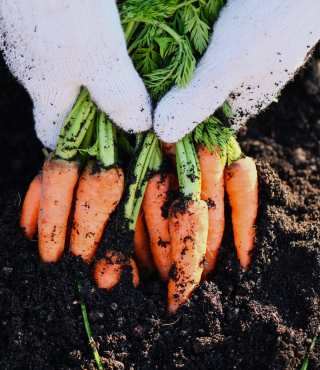
Harvesting Carrots
Harvesting carrots is an exciting process that marks the culmination of your hard work in growing these vibrant root vegetables. To ensure the best taste and nutrition, it’s crucial to harvest carrots at the right maturity stage. In this section, we’ll cover the signs to look for when determining their maturity, various techniques for harvesting, and tips on post-harvest care.
Maturity Signs
Identifying when your carrots are ready for harvesting is essential for enjoying their optimal flavor and texture. As these versatile vegetables develop over time, here are the key signs to look out for:
- Size: Carrots typically reach maturity when they reach around 1 inch (2.5 cm) in diameter.
- Color: The vibrant orange color should be uniform throughout the carrot, indicating maturity.
- Texture: Gently rub the top part of the carrot’s shoulders. If it feels smooth and without any ridges or bumps, it’s likely ready for harvest.
Harvesting Techniques
When it comes to harvesting carrots, employing the right techniques ensures minimal damage and maximizes quality. Follow these steps:
- Loosen the ground: Begin by loosening the soil around the carrots using a garden fork or trowel. This prevents unnecessary breakage while pulling them out.
- Grasp the tops: Firmly hold the carrot greens near the top, close to where they emerge from the ground.
- Wiggle and pull: Gently wiggle the carrot while applying light pressure to pull it out. If the soil is excessively compacted around the carrots, use a fork to assist in loosening the ground without causing damage.
- Trim the greens: Once harvested, trim the greens to about an inch (2.5 cm) above the carrot’s shoulder. This helps to prolong storage life.
Post-harvest Tips
Proper post-harvest care is essential to maintain the freshness and flavor of your harvested carrots. Here are a few tips to follow:
- Remove the foliage: After trimming the greens, remove any remaining foliage. This prevents the greens from drawing moisture and nutrients away from the carrot.
- Cleaning: Gently brush any excess soil from the carrots, but avoid washing them, as excess moisture can lead to rotting.
- Storage: Store harvested carrots in a cool, dark, and humid environment to maintain their quality. Refrigeration or using a root cellar are excellent options.
- Storing with sand: For long-term storage, you can place the carrots in a container filled with slightly moist sand to prevent them from drying out.
By following these harvesting and post-harvest tips, you can enjoy the fresh, delicious taste of homegrown carrots to their fullest potential.
Troubleshooting Common Issues
While growing carrots can be a rewarding experience, it’s not uncommon to encounter a few hurdles along the way. To help you overcome these challenges and ensure a bountiful harvest, we’ve put together a list of common issues that you may come across when growing carrots. From diseases to pest infestations to general growing challenges, we’ve got you covered.
Carrot Diseases
Unfortunately, carrots are susceptible to various diseases that can hinder their growth and overall health. Here are some common carrot diseases:
- Fusarium Wilt: This disease is caused by a soil-borne fungus and affects the root system of carrots. Look out for wilting leaves and yellow discoloration.
- Leaf Blight: Leaf blight is characterized by brown spots on carrot foliage, leading to stunted growth. Promptly remove and destroy affected plants.
- Root Knot Nematodes: These microscopic pests can cause deformities in carrot roots. Rotate your crops regularly and avoid planting carrots in the same spot every year.
To prevent the spread of diseases, ensure that your carrots have adequate spacing between them for proper airflow. Practice good crop rotation and maintain a healthy soil pH level.
Pest Infestations
Carrot crops can fall victim to a wide array of pests. Here are a few common offenders:
- Carrot Rust Fly: These flies lay eggs near carrot plants, and their larvae feed on the roots, leading to distorted growth. Use row covers or nets to protect your carrots from these pesky insects.
- Aphids: Aphids are tiny insects that typically feed on leaves and stems, causing yellowing and stunted growth. Introduce beneficial insects like ladybugs or spray neem oil to control aphid populations.
- Wireworms: These larvae of click beetles can gnaw on carrot roots, resulting in irregular tunnels and damage. Employ sticky traps or beneficial nematodes to combat wireworm infestations.
Regularly inspect your plants for signs of pest activity, and take immediate action when necessary. Creating a diverse and balanced ecosystem in your garden can also help with pest control.
Growing Challenges
Aside from diseases and pest infestations, there are several general growing challenges to be aware of:
| Challenge | Solution |
| Poor Germination: | Ensure the soil is well-drained, loose, and free from debris. Optimal soil temperature for germination is approximately 70°F (21°C). |
| Carrot Forking: | Avoid compacted soil by loosening it before planting. Remove rocks or anything that could impede carrot growth. |
| Poor Carrot Size: | Thin the seedlings to provide ample space for each carrot. Adequate soil moisture and fertility are also crucial for proper growth. |
By addressing these growing challenges, you can increase the likelihood of a successful carrot harvest. Regularly monitor your plants and make adjustments as needed to promote optimum growth conditions.
Frequently Asked Questions On Growing Stages Of Carrots
What Are The Different Stages Of Carrot Growth?
Carrots go through four major stages of growth: seed germination, leaf growth, root formation, and maturation.
How Long Does It Take For Carrots To Germinate?
Carrot seeds typically take about 10 to 21 days to germinate, depending on factors such as moisture, temperature, and soil conditions.
What Is The Best Time To Harvest Carrots?
Carrots are usually ready to harvest 60 to 80 days after planting, when the roots have reached a desirable size and color.
Conclusion
To conclude, understanding the growing stages of carrots is crucial for any gardener or enthusiast. By planting the right variety, providing proper care, and nurturing the plants through each stage, you can ensure a bountiful harvest. So whether you’re a beginner or experienced gardener, remember to start with healthy seeds, maintain the right soil conditions, and give your carrots the attention they need.
Enjoy the satisfaction of growing your own delicious and nutritious carrots right in your backyard. Happy growing!
